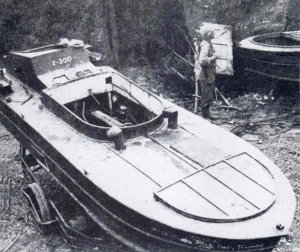![]() The Pacific War Online Encyclopedia
The Pacific War Online Encyclopedia
|
| Previous: Shinshu Maru, Japanese Landing Craft Depot Ship | Table of Contents | Next: Shinyo, Japanese Escort Carrier |

U.S. Navy. Via Wikimedia Commons
Type 1 Shinyo
|
Tonnage |
1.35 tons |
|
Dimensions |
19.7' by 5.4' by 1' 6m by 1.64m by 0.30m |
|
Maximum speed |
18 knots with warhead |
|
Complement |
1 |
|
Armament |
551-661 lb (250-300 kg) explosive charge |
| Propulsion |
1 Toyota KC Special Type automobile engine 2 120mm SO-RA rockets |
| Production |
6197 of all types |
Type 5 Shinyo
|
Tonnage |
2.2 tons |
|
Dimensions |
21' by 5.8' by 2.9' 6.4m by 1.77m by 0.88m |
|
Maximum speed |
30 knots |
|
Complement |
2 |
|
Armament |
551-661 lb (250-300kg) explosive
charge 1 13mm/76 machine gun |
| Propulsion |
2 Toyota KC Special Type automobile engines 2 120mm SO-RA rockets |
| Production |
Over 6000 were produced before the end of the war |
The Shinyo ("Sea Quake") were small motor boats intended for suicide
attack. They were built of plywood
and powered by automobile engines and carried a large explosive charge
in their noses. The pilot was expected steer the boat into an Allied ship,
using the SO-RA rockets for last minute acceleration, with the charge
exploding on impact. The slightly larger Type 5 variant was intended as
a command boat and was likely produced in much smaller numbers.
The Japanese Army produced its own special attack boat, the Maru-ni, which was first encountered by the Allies in the Philippines and was not actually a suicide boat. This version carried a pair of 120kg (265 lb) depth charges, one on each side of the cockpit, which were to be released alongside an Allied ship, giving the boat a theoretical possibility of escaping before the charges went off six seconds later. A few crewmen actually survived carrying out such attacks, though not with their boats intact.
Out of over 6000 shinyo and 3000 maru-ni produced before the surrender, the great majority were retained in Japan for use against any Allied invasion. About 400 were committed to the Phillipines or Okinawa.
These boats sank perhaps seven Allied auxiliaries and damaged a number of others, including destroyer Hutchins, but thereafter the Allies took precautions
against the boats and those at Okinawa were neutralized before they could achieve anything.
References
Branfill-Cook (2014)The Pacific War Online Encyclopedia © 2011, 2013, 2015 by Kent G. Budge. Index